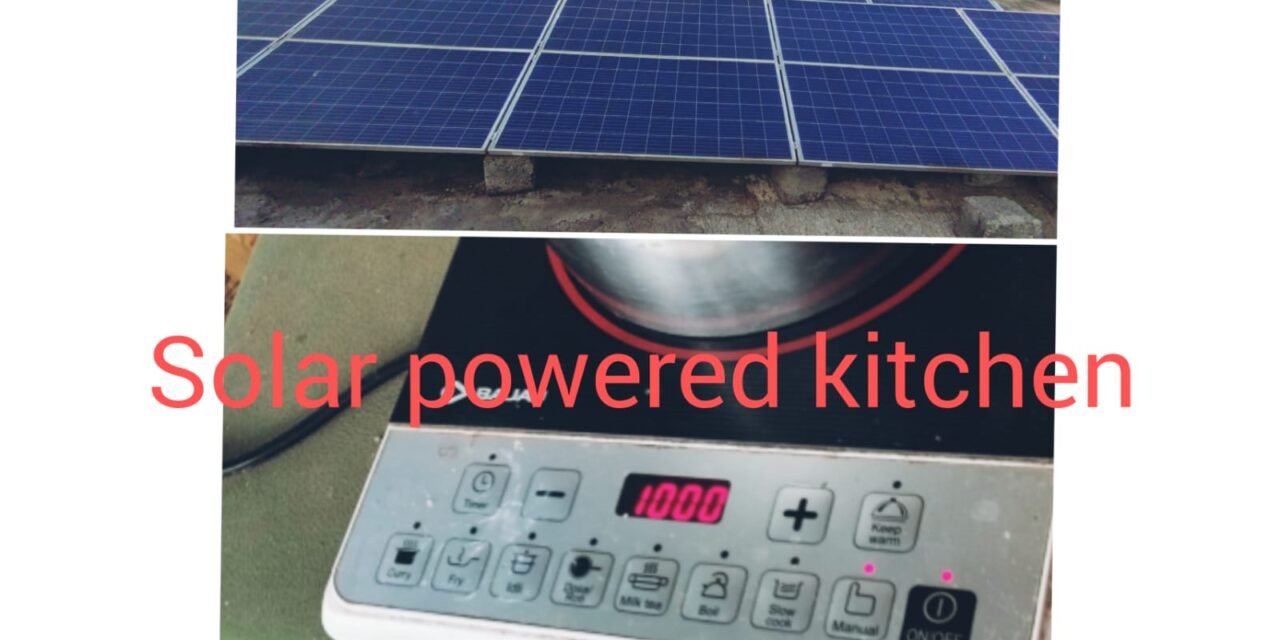Introduction:
How Solar Photovoltaic System Works?
PhotoVoltaic materials and devices convert sunlight into electrical energy. A single PV device is known as a cell. An individual PV Cells usually small, typically producing about 1 or 2 watts of power. These cells are made of different semiconducting materials and are often less than the thickness of four human hairs. In order to withstand the outdoors for many years, cells are sandwiched between protective materials in a combination of glass and/or plastics.
To boost the power outfit of PV cells, they are connected together in chains to form larger units known as modules or panels. Modules can be used individually, or several can be connected to form arrays. One or more arrays is then connected to the electrical grid as part of a complete PV system. Because of this modular structure, PV systems can be built to meet almost any electric power need, small or large.
PV modules and arrays are just one part of a PV system. Systems also include mounting structures that point panels toward the sun, along with the components that take the direct-current (DC) electricity produced by modules and convert it to the alternating-current (AC) electricity used to power all of the appliances in your home.
How does on-grid solar power system works?
The arrangement of solar modules absorbs the sunlight on them and convert them into electricity. The current generated here is Direct Current (DC). The solar inverter then converts the DC to Alternating Current (AC), thus making it power the electrical items. This electricity is then routed to the grid where it is supplied for day to day use. An important feature is a net meter. It is a device that records the energy supplied to the grid and the energy consumed. At the end of each month, the outstanding is recorded and the consumer is provided with a bill.

Benefits of on-grid solar –
1. Zero Electricity Bills – Though the solar power system is connected to the grid, the consumer has to pay only for the surplus electricity he consumes. The bill generated on a monthly basis determines whether the consumer has any payments to be made. However, at the same time if the consumer utilizes less electricity, the excess is fed back in the grid.
2. Easy maintenance – The on-grid-solar power system has the least number of parts along with simple installation. The elimination of batteries makes the maintenance quite easy.
3. Passive income generation – With a connection to the grid, the consumer can charge for the surplus electricity he has generated. It not only eliminates your electricity bills but also avails the cost benefits for the excess electricity generated.
4. Reduction Of Carbon Footprints: By using solar power we can reduce the electricity consumption which produced by burning of coal.
On-Grid System In Vigyan Ashram:

‘Vigyan Ashram’ produces 32.5 kW of daily power generation by using on grid solar pv system. All generated electricity is exported to MSEB ( Maharashtra State Electricity Board), and single phase electricity is imported or consumed from MSEB. Vigyan Ashram export more units than the consumption of electricity from MSEB.An important feature is the net meter. It is a device that records the energy supplied to the grid and the energy consumed.
How Much Conventional Energy Is Used In kitchen Of Vigyan-Ashram
- In the kitchen of vigyan ashram, LPG-gas and wood is used for the cooking of 2 times of chapatis for 60 students and for the boiling of 12 lit milk.
- Hence For cooking Vigyan ashram uses 30 kg of LPG per month.
Need Of Project:
- It is a need to reduce the consumption of conventional sources of energy.Conventional sources of energy like wood cow dungs etc.are harmful for environment .So its need of a time that we should replace our energy sources to renewable energy sources,with energy sources like Solar Energy,Wind-Energy such renewable sources of energy.
- Vigyan Ashram’ produces 32.5 kW of daily power generation by using on grid solar pv system. All generated electricity is exported to MSEB ( Maharashtra State Electricity Board), and single phase electricity is imported or consumed from MSEB.
- Vigyan Ashram export more units than the consumption of electricity from MSEB. Vigyan ashram can use extra generated electricity and replace conventional sources of energy.
- For On-grid solar system ,MSEB( Maharashtra State Electricity Board) doesn’t pay any charges to consumer for giving extra units generated by solar on grid system.
Objectives:
- To take account of electricity generation by PV panel and consumption.
- To suggest ecological and economical option for energy consumption at vigyan ashram.
- To give cost-benefit analysis after replacing the LPG gas-cooking by electric cooking.
Process:

7 nov 2022
Accounting the electricity Generation by solar PV system and consumption Of Electricity:
- Electrical and Energy Lab of vigyan ashram have daily records of consumption of electricity
- I collected data of two months Aug.2022 and Sep.2022 from meter reading notebook of electrical and made a excel sheet of consumption of electricity , total banked units which is given in below file.
- I noticed that minimum extra 800 units are exported by on grid solar system of vigyan ashram.
- Also average consumption per month by vigyan ashram is between 80-100 units.
Hence we concluded that vigyan ashram have much reserved units of generation of electricity, which can we easily utilize for cooking and other better purpose. we also referred previous electricity bills of vigyan ashram by MSEB. Here is its photos.


Ecological Option For Energy Consumption In Vigyan Ashram:
Vigyan-Ashram uses electricity generated by Solar-On grid system for all uses in ashram, i did survey in ashram and found that except in the kitchen of vigyan ashram where amount of wood and LPG is used. So I decided that it can be replaced by electrical cooking
Consumption Of LPG in kitchen Of Vigyan Ashram:
- Vigyan-Ashram kitchen needs two commercial tanks per month 30kg per month.
- For boiling milk of 12lit. of daily around 150gm LPG is used .
- To boil milk vigyan ashram needs 4500gms i.e 4.5 kg of LPG per month
Calculation Of Electricity Consumption For Induction to boil milk daily


To calculate consumption required by Electric-Induction We put 1 lit water to boil on induction.
We required about 0.1 unit consumption to boil 1 lit of water at 950 c from 250 c
Now to confirm, whether consumption is correct or not I decided to check by calculating it
By specific heat efficiency formula.
Specific Heat Efficiency, C= Q/m (∆T),
where,
Q= Energy/Heat required in (joule) ,
m= mass(g) ,
(∆T)= Change in temperature0 c,
Data:
1) Initial Temperature T1 = 250 c,
2) Final Temperature T2 = 950 c , Mass, m = 1000gm ,
3) Change In Temperature,T2-T1 = 95- 25 = 700 c,
4) Specific Heat Capacity Of Water C = 4.2 J/g0 c,
Solution:
C = Q/m (∆T) ,
Q = m C(∆T),
= (1000)(4.2)(70) ,
= 294000 J ,
= 0.0817 KW h ,
which is nearly equal to reading got on meter reading i.e 0.1 unit , So now we can calculate the total electricity need for milk also on the basis of Specific Heat Capacity Of Milk. I measured temperature of normal raw milk , which was 220 c , We need to boil milk till 900 c
Specific Heat Capacity Of Milk ,C = 3.89J/g0 c , Initial Temperature T1= 22 0 c , Final Temperature T2 = 90 0 c , (∆T) = 77 0 c
Q = m .C (∆T) ,
= 12000 ( 3.89) ( 77 ) ,
= 3,594,360 J ,
= 0.99 KW,
so we will need nearly 1 unit of electricity daily to boil milk for 60 students i. e 12 lit. milk., if we use electric induction. So approximately ashram will need 30 units of electricity per month to boil milk of 12 lit. daily
Ecological Benefits After Replacing LPG Cooking By Electric Cooking
Calculations of carbon emission by LPG cooking/Carbon footprints of LPG cooking:
1 liter of LPG weighs 550 grammes. LPG consists for 82,5% of carbon, or 454 grammes of carbon per liter of LPG. In order to combust this carbon to CO2, 1211 grammes of oxygen is needed. The sum is then 454 + 1211 = 1665 grammes of CO2/liter of LPG.
1 kg = 1.96 L of LPG,
Vigyan-Ashram kitchen needs two commercial tanks per month i.e 30kg per month.
Therefore for 30 kg = 30*1.96 ,
= 58.8 lit of LPG
Total carbon emitted by burning 30 kg of LPG = 1665.(58.8), 97902gm,
i.e 97.902kg of CO2 is emitted by LPG for cooking in vigyan ashram.,
For milk kitchen needs 8.82 lit of LPG
8.82*1665
= 14,685 gms
= 14.68 kg, So 14.68kg of CO2 is emitted by LPG cooking in vigyan ashram.
By replacing LPG cooking by electric cooking we can reduce the 14.68kg of carbon dioxide emission per month in environment.
Economical/Cost- Benefit Analysis:
As we know vigyan Ashram needs around 5 kg of LPG to boil milk monthly,
Current LPG rate in Pune,Maharashtra is 1056 rs for 14.2 kg,
i.e 74.35rs. per kg ,
So Vigyan Ashram Needs 74.35.(5) = 371.75 rs per month to boil milk by LPG cylinder.
To boil milk by electric induction we need 1kwh daily i.e 1unit.
So Vigyan-Ashram will save total 1115rs per month after replacing LPG cooking by Electric cooking.
selection of induction:

I selected a electric induction Prestige Atlas 3.0 Induction Cooktop on flipcart.com .You can refer it online https://www.flipkart.com/prestige-atlas-3-0-induction-cooktop/p/itm171641d916862?pid=ICTG53G7BUZYGS9X&lid=LSTICTG53G7BUZYGS9XHJPHQF&marketplace=FLIPKART&cmpid=content_induction-cook-top_8965229628_gmc
| 1) | Brand | Prestige |
| 2) | Model Name | Prestige Atlas 3.0 Induction Cooktop |
| 3) | Power consumption | 1200w |
| 4) | Power Input | AC 220-240 |
| 5) | Cost | 1849 /- |
monthly saving after replacing LPG by electric induction for boiling milk = 371.5,
Price Of Induction = 1849,
Time requirement to return the investment of LPG = 1849 / 371.5,
= 4.97
= 5 months
If Ashram replace using LPG for boiling of milk by electric induction ashram will return its investment in 5 months.
Conclusion Note:
- On grid solar pv system of Vigyan-Ashram generates 900 kwh of electricity per month.
- Maximum Consumption of single phase electricity of Vigyan- Ashram is 300-350 unit per month and Average consumption of single phase electricity is 100 units per month.
- We can reduce 90 kg of carbon-dioxide emission in environment by using electric induction.
- Replacing LPG by electric induction cooking Vigyan ashram can save 1115rs per month i.e 13380 rs per year.



